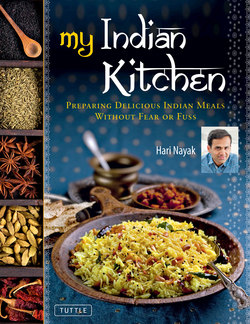Читать книгу My Indian Kitchen - Hari Nayak - Страница 10
На сайте Литреса книга снята с продажи.
ОглавлениеPairing Wines with Indian Food
Traditionally the enjoyment of wine is not part of the Indian lifestyle. When I was growing up in India, the preferred alcoholic drinks were scotch or beer. Drinking was a pre-dinner activity, though drinks were usually paired with freshly made snacks such as spicy kebabs and papadams. To this day, I still prefer a chilled glass of beer when choosing an alcoholic beverage to pair with an Indian meal. Many Indian restaurants will carry beer on their menu, including Indian beers (especially Kingfisher). The best beers to pair with Indian food are relatively light beers—that is, pilsners, lagers and ales. Dark or strongly flavored beers such as stouts, porters and bocks should be avoided.
For wine lovers, pairing wine with Indian food is complicated and challenging, as there are a lot of competing spices and seasonings to contend with. The complex layering of spices and chili heat in Indian dishes makes it tricky. The traditional method of pairing lighter food with whites and heavier foods with reds does not necessarily hold true in Indian cuisine—for example a heavy dish such as creamy lamb curry or beef korma will pair well with whites and a flavorful seafood dish can go well with reds.
The important rule to remember is that there is no rule!!
After consulting several wine experts and master sommeliers, I’ve come up some general tips to help you make good wine selections:
The lesser the alcohol level the better because alcohol tends to intensify the heat in a dish. For a white, try something like a Gazelle Vinho Verde from Portugal, which has only 9 percent alcohol, or just about any sauvignon blanc from France’s Sancerre region. Those wines usually have alcohol levels no higher than 13 percent. For a red, try the Heron pinot noir, from the Languedoc region of France, which has an alcohol level in the 13 percent range.
Reds with less oaky and more intense fruit flavors works well with the complex tastes of the cuisine.
Whites with light acidity and mild fruity textures will balance the richness of the Indian dishes.
The refreshing bubbles and palate-cleansing acidity of sparkling wines would also work with Indian dishes that have heavy sauces.
A dry rose, which has some of the complexity as a red as well as the acidity of a lighter white, can also be paired next to a lot of Indian dishes.
Here are some specific suggestions—but they are suggestions only. Following the basic tips above, other wines may be chosen.
Gewürztraminer: Since “gewürztraminer” literally means “spicy grape” in German, this wine can pair perfectly with the spices and seasonings in Indian cuisine, especially ginger and cardamom. And since many bottles have a bit of residual sugar, gewürztraminer will tame the heat in curries and other spicy dishes.
Riesling: With aromas and flavors of crisp apple and peach, good acidity, and often a hint of sweetness, Riesling is a match made in heaven for Indian cuisine. Try a glass or a bottle the next time you have a curry dish made with fruit like peaches or apricots. And, as with gewürztraminer, the touch of sugar in the wine will counter the heat in chili peppers and other spices.
Sauvignon Blanc: Sauvignon Blanc’s enticing flavors of lime, grapefruit, gooseberries and herbs make it a food-friendly choice for any cuisine, as the bracing acidity wakes up your taste buds and makes you want to go back for another bite of whatever you are eating. Try it with dishes that include tomatoes, lemons or limes, which will match the wine’s acidity. With coconut milk–based curries and other rich dishes, sauvignon blanc will cut some of the richness and taste extremely refreshing.
Rosé: Not to be confused with white zinfandel, rosé wine is completely dry. It has some of the complexity and weight of a red wine (think red berries and spice), as well as the acidity of a lighter white. Rosés can hold their own next to a lot of Indian dishes, including those made with lamb. Since rosé tends to be drier I suggest not pairing it with some of the spicier Indian dishes like vindaloo or murg kali mirch since it doesn’t have the sugar content that helps counter chili heat
Sparkling wine: Often underrated as a food wine, and saved for special occasions, Champagne and other sparkling wines can be enjoyed with many different kinds of food. The refreshing bubbles and palate-cleansing acidity would especially work with Indian dishes that have heavy sauces. When choosing champagne to accompany Indian dishes with a lot of chili heat, choose a sweeter champagne as its higher sugar content works well with spicy foods. Also, a chilled glass of Prosecco, with its sweet, rich and complex flavor, works very well.
Pinot Noir: Crave a bottle of red wine with your Indian food? Pinot noir is a smart choice, as it offers lots of fruit (cherries, raspberries, cranberries,) but typically has silkier, smoother tannins than more full-bodied red wines such as cabernet sauvignon or merlot, so it won’t dry out your mouth or fuel the fire of a spicy dish you are enjoying. If you are serving a variety of Indian dishes at your next dinner party pinot noir is a great selection. It can pair with everything from tandoori chicken, to khadai stir-fried shrimp and palak paneer kofta.
